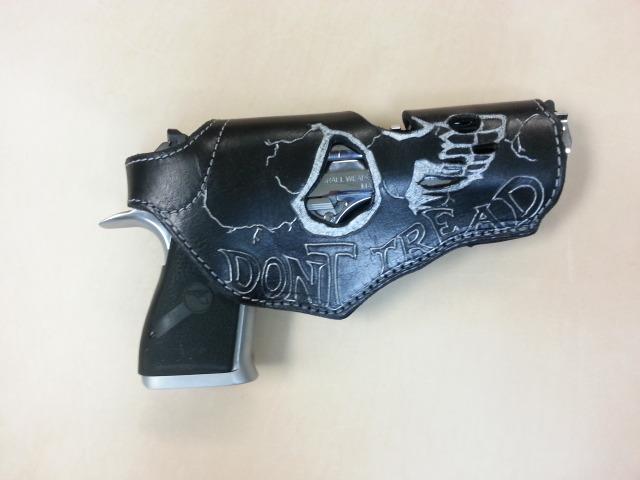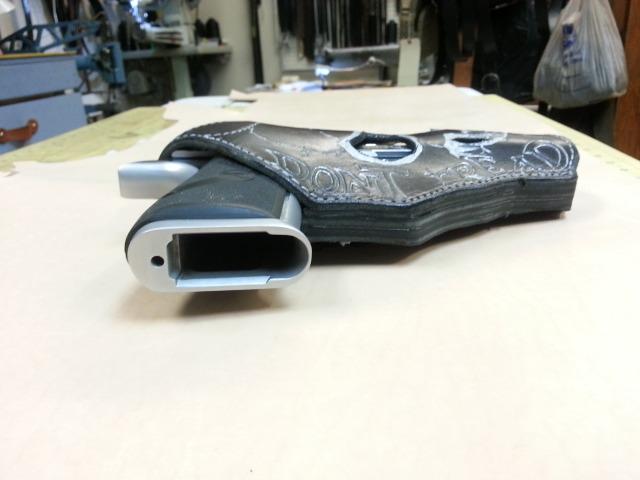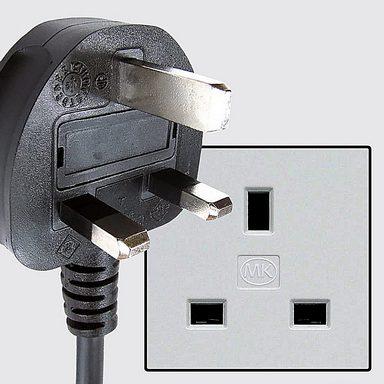-
Posts
7,778 -
Joined
-
Last visited
Content Type
Profiles
Forums
Events
Blogs
Gallery
Everything posted by Wizcrafts
-

Pfaff 145 H3 outer pressure foot does not raise
Wizcrafts replied to ThomasBH's topic in Leather Sewing Machines
Try reinstalling the stock feet. Does that fix it? If so, the replacement/aftermarket feet may be the wrong height. -
Do you want an inline S point, or some slanted chisel point? Schmetz makes the S point in system 134-35. I have a pack I use once in a while on my Singer walking foot machines. My machines are timed so that I can use these slightly shorter needles and not skip stitches, but only on one direction machines. If your machine has reverse you might want to lower the needle bar 1/2 mm or so to put the eye at the same position as the system 135x16 needles. Machines with reverse are more finicky when it comes to timing in both directions.
-
I searched for a while and this is the best source I can come up with at this time. https://sew-europe.com/schmetz.htm The list Schmetz and Gross Beckert on the home page. I hope this helps.
-

Pulling my hair out over tension issues with Consew 206rb
Wizcrafts replied to Lokahi's topic in Leather Sewing Machines
I usually use a #23 needle with #138 thread, top and bottom. Link please! -
I know that this topic has reached its intended outcome. But, I want to share my primary source of YKK zippers and zipper parts and tools, as well as the double sided tape I use to secure them for sewing. Wawak.com stocks a huge amount of zippers in tooth widths up to #10 (chaps size), in various lengths and colors. They have top and bottom stops, pullers and tools. Here is the Zippers landing page. The double sided tape get from Wawak is called HyperStik and is listed on this page. This is really aggressive tape. If your needle sews through the tape it will tend to gum up. To counter this I only use titanium or Gebeder needles when sewing through the tape. Plus, I keep a jar of Goof Off nearby and dip a dauber into it, then wipe the needle down every so often as I sew through the tape. If the machine has a lube pot, I pour in silicon lube and run the thread through it. Both of my patchers have stock lube pots and it's trivial to pour in a bit of silicon lube.
-
I still have a couple of spools of black thread that are so coily that I feed them up from the floor to the thread stand guides, then do my counterclockwise wrap around the top post holes. Without these countermeasures the thread would be useless and it cost a lot of money when I bought it.
-
Check out Gross-Beckert and Organ brand needle suppliers on Ebay.
-

Interested in Writing About Leathercraft?
Wizcrafts replied to ClassicCrafter's topic in Marketing and Advertising
I moved your post to the Marketing and Advertising section. If left in Help Wanted, all replies have to await approval from a moderator and can only be posted in that topic. Here, any member can reply to you, including via our private message system. Good luck in your endeavor! -
You might have overly twisty thread that is wrapping around itself, or around guide posts, suddenly increasing the top tension. Or, the thread may be poorly wound on the spool. Or, the thread coming from the spool may be caught under other windings causing uneven tension off the spool. If your machine has a top mounted thread guide post with holes on the top and then about an inch below, try wrapping the thread through the top, then counterclockwise around to the bottom hole and out. This will counteract any excessive clockwise coiling from the spool. It's also possible that the bobbin thread is jumping out of the tension spring because of how it was wound, or due to coiling. Pull out a few feet of bobbin thread and get a feel for the smoothness and evenness of the pull. If it seems to lift out of the spring, pull out the bobbin and reverse its direction of feed.
-

Sewing machine for thin leather. Advice?
Wizcrafts replied to Hairic's topic in Leather Sewing Machines
See if you can find an old Singer 31-15 and convert it into a roller foot machine. The conversion kits contain 3 parts: A roller foot, a wide single row feed dog, and a matching throat plate. With these parts installed and the machine threaded with either #46 or #69 thread, it will sew wallet interiors with ease. The rollers are usually available in 3/4 and 1 inch diameters. The smaller wheel makes it easier to make sharp turns. The visibility is incredible with the needle coming down right next to the bottom edge of the slanted wheel and no other foot in the way. Note, this setup requires some stiffness in the leather to keep the leather from puckering up with the needle, which can cause skipped stitches. -
Marks on both sides tells me he sold you a top and bottom driven upholstery walking foot machine. That type of dual feed uses teeth on the top and bottom to drag difficult materials through the machine. It doesn't leave marks on seating vinyl, outdoor canvas, duck cloth, sail cloth, most upholstery leather, webbing, Velcro garment leather and cloth and denim. Dealers who don't specialize in selling to leather workers and harness makers make this mistake a lot. The type of machine you actually need to sew leather that is mark-able without leaving tooth marks, is a compound (triple) feed walking foot machine, with smooth feet and feed dog. We have dealers who support the forum and who specialize in sewing machines that don't leave marks on leather. Some even supply stainless steel feet to avoid darkening moist leather. Two of those dealers are Toledo Industrial Sewing Machines, in Ohio (Cowboy), and Leather Machine Company, in California (Cobra). Techsew is based in Canada, but exports to the USA. These three are very knowledgeable when it comes to recommending the best machine for a particular range of sewing jobs involving leather and other materials. I have dealt with Toledo Industrial Sewing Machines multiple times, as well as Leather Machine Company. I have never been sold a machine that wasn't suited to the job I intended to use it for. As a professional sewer, I welcome you both the the USA and Leatherworker.net. Working with leather sewing machines has a life of its own. Buckle in and enjoy the ride! Since you have experience working on shoes, you no doubt have used shoe patchers and sole stitchers. We frequently discuss patchers and once in a while curved and straight needle stitchers are brought up in topics. These machines have cousins in the heavy leather field in the form of harness stitchers using a barbed needle and a stabbing awl.
-
There most definitely is a Cowboy dealer in Australia. We have a lot of members down under who are valued contributors to this forum. I will try to get you the name of the Cowboy dealer in Australia.
-
The Juki and Adler you listed are among the best. They are also very expensive, You can probably find an authorized dealer of these brands and visit their shop to test them out with your materials. You haven't listed your current, or new location in your profile. What city and State are you living in? There may be industrial sewing machine dealers within driving distance. If you find an industrial sewing machine dealer and settle on the type of machine, or machines that are suitable, report back here about your preferences. Maybe we know someone who sells clones of the machines that are perfectly capable of doing the same job at half the price.
-

Minimum and Maximum Thread Sizes for Pfaff 145?
Wizcrafts replied to ethereal's topic in Leather Sewing Machines
I only use the 31-15 to sew non leather materials together. If I need to sew a lining into something made of leather, I use a walking foot machine. As for the needles, there is no harm using a round point needle on garment or chap leather. The plus is that the round point wont split the fibers in the lining. Regarding round point vs leather point when sewing patches onto leather vests, I started using round points for this work. The reason is that some leather point configurations split the embroidered threads on the patches, whereas the round points are less likely to do that. The embroidery is done with round point needles, so the stitching to attach them should be also. Nobody sees the round holes in the leather under the patches. -

Minimum and Maximum Thread Sizes for Pfaff 145?
Wizcrafts replied to ethereal's topic in Leather Sewing Machines
The min and max thread sizes depend on the build of your machine (hook, bobbin size, throat plate, take-up lever, feed dog, tension and pressure springs). When I had that model it was only good up to #138 thread, using a #160 needle. It also worked great with a #150 needle. I think you'd need a more recent version that includes the letter H on the model tag to run #207 thread. As for the minimum size, any thread smaller than Tex 50 and a # 14 needle might require a smaller hole in the feed dog and a closer hook to needle spacing. The thread tension spring might need to be lighter duty. My walking foot machines are all setup for medium to heavy duty sewing and #69 thread minimum. They eat cloth and just gobble up or break thin thread. I keep a Singer 31-15 straight stitch machine on hand to handle soft cloth, linings and wallet interiors. -
First, ask the seller if it comes with some extra needles, awls and bobbins. If no extras, does it at least have those in the machine now? For parts, contact Lisa Sorrell or else, Southern Leather. I see that Zach White also has ASN needles for sale. You may also be able to locate some prewound bobbins somewhere. It's always a gamble buying discontinued machinery. If you are able to find parts and accessories at all they may cost a lot more than you'd expect. If you buy the machine, here is a video describing the threading and setup of an American Straight Needle machine.
-

Which Adler Heavy Duty Flatbed..?
Wizcrafts replied to TheMackinaw's topic in Leather Sewing Machines
I once had an Adler 204-370 which could sew 3/4 inch with up to #346 thread. The head weighed about 125 to 150 pounds. It had warped the wooden table that came with it. It is a compound feed walking foot machine, identical to the 205-370 cylinder arm version, but a flatbed. This machine is out of production now. The equivalent is a Cowboy cb243. It is huge, just like that Adler! -
If the 2750 is similar to my Techsew 2700, it is based upon the Consew 227R. Below is a manual for the Consew 227R, which includes a plate showing how to time the feed dog. Here is a link to Techsew's YouTube videos pertaining to adjusting the TS-2750 machine. CB227R_Oper.Manual_print_pages_3-13.pdf
-
@JonesCoLeatherworks What model is your Techsew? It must be a clone of some major machine for which there will be an adjusters' manual.
-
If indeed the presser bar and inside foot bar are identical to a cb3500, you can buy accessory feet from our Cowboy dealer, Toledo Industrial Sewing Machines. Click on the link for available accessories for this machine. There are links in that popup to view pictures of various feet and other parts.
-
No! lol The edge stitching was about 1/4 inch in. Then I sanded, slicked and dyed the welted area.
-
The most thickness I have sewn on my Cowboy cb4500 is 1 inch, in January of 2015. I had to increase the height of the presser foot and reduce the alternating height. I think I also removed the feed dog and curved throat plate and installed the thin slotted needle plate. It was difficult and left some top and bottom drag marks that I was able to smooth out. The photos show the holster I sewed along the outside edge, which with the inside welts measured 1 inch along the stitch line.
-
If the feed dog never rises to the top of the slot in the throat plate, you are sewing with dual feed, without bottom assist. I set my feed dog so it just slightly rises above the top of the throat plate (maybe 1/2mm). It should remain on top for the entire forward or reverse feed cycle. If you experience trouble feeding some heavy work, increase the lift. With the feed dog below the surface you are in dual feed mode. The only downside I find is the the reverse stitches may not match the forward stitch length unless you tweak the stitch length. Note, that if you use the holster or stirrup throat plate, you have no functioning feed dog in the picture and are in dual feed mode..
-

Dipping my toe into sewing; Advice requested
Wizcrafts replied to Sam83's topic in Leather Sewing Machines
Before any further talk about importing a motorized sewing machine directly to Dubai, one should be aware of the power situation there. What is the mains voltage in Dubai? Just like the rest of the Middle East, the voltage in Dubai is 230 volts and the frequency is 50 Hz. 230 V ~ 50 Hz Any motorized machine, especially those with a built in or solidly attached motor would need to operable at 230 volts, at 50 cps and have this plug.- 45 replies
-
- sewing machine
- newbie
-
(and 1 more)
Tagged with:






